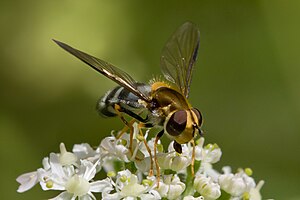Blue broadband hover fly
| Blue broadband hover fly | ||||||||||||
|---|---|---|---|---|---|---|---|---|---|---|---|---|

Blue broadband hover fly ( Leucozona glaucia ) |
||||||||||||
| Systematics | ||||||||||||
|
||||||||||||
| Scientific name | ||||||||||||
| Leucozona glaucia | ||||||||||||
| ( Linnaeus , 1758) |

The blue broadband hover fly ( Leucozona glaucia , syn .: Ischyrosyrphus glaucius ) is a fly from the family of hover flies (Syrphidae).
features
The flies reach a length of 10 to 12 millimeters and have the syrphus- like body structure typical of hoverflies . The forehead is colored yellow and has a hairy black antennae. The feelers are colored black. The face of the females is yellow and is traversed by a black central welt that extends from the ocelles to the antennae. The male has no central welt. The scutellum can vary from brownish yellow to light yellow and is hairy yellow. The abdomen is elongated and narrow and has a velvety black color, which is interrupted by three very broad and bluish bands. One can clearly distinguish the species from the similar white broadband hover fly ( Leucozona laternarius ) by the brownish yellow label and the bluish bands , as this has a dark label and whitish bands.
Occurrence
The distribution area of blue broadband hoverflies extends from Europe to Japan. In Central Europe they are particularly common in the mountains and next to rivers, in oak forests and riverside gallery forests that are interspersed with bacteria. There on forest paths, forest aisles and not infrequently on meadows. They fly from May to September, with the peak of the flight time in July and August.
Way of life
The adults move most of their life on trees or bushes (arboreal) and as flower visitors on various plants. There preferred on umbelliferae , where they absorb nectar and pollen with their mouthparts. The larvae live zoophag on aphids . They are Univoltin , which means that they produce one generation per year.
swell
- Olaf Bastian: Hoverflies. Die Neue Brehm-Bücherei Vol. 576 Westarp Sciences, Magdeburg 1994, ISBN 3-89432-469-4
- Joachim and Hiroko Haupt: Flies and mosquitoes: observation, way of life. Naturbuch-Verlag, Augsburg 1998, ISBN 3-89440-278-4 .
- Kurt Kormann: Hover flies and bladder-head flies of Central Europe Fauna Nature Guide Volume 1, Fauna-Verlag, Nottuln 2002, ISBN 3-935980-29-9
- Speight, MCD (200) Species accounts of European Syrphidae (Diptera) 2010. Syrph the Net, the database of European Syrphidae, vol. 59, 285 pp., ISSN 1393-4546 . Syrph the Net Publications, Dublin.